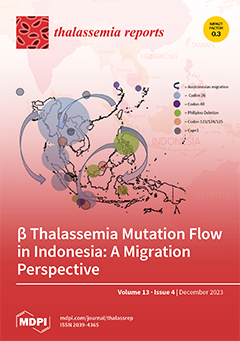Background and aim: We conducted a review to determine the efficacy of amlodipine alongside iron chelators on serum ferritin levels and liver T2-weighted magnetic resonance imaging (MRI T2*) in β-thalassemia patients.
Methods: Systematic search was conducted in multiple databases, including Web of Science,
[...] Read more.
Background and aim: We conducted a review to determine the efficacy of amlodipine alongside iron chelators on serum ferritin levels and liver T2-weighted magnetic resonance imaging (MRI T2*) in β-thalassemia patients.
Methods: Systematic search was conducted in multiple databases, including Web of Science, PubMed, Scopus, Embase, Cochrane Library, ClinicalTrials.gov, the Iranian Registry of Clinical Trials (IRCT), ProQuest, OpenGrey, and Web of Science Conference Proceedings Citation Index. The search was closed in January 2023. Primary outcomes were comprised of liver MRI T2* (millisecond (msec)) and serum ferritin levels (ng/mL).
Results: Seven studies (n = 227) were included in the study. The pooled Cohen’s d for serum ferritin was estimated at −0.46, 95% confidence interval (CI) −1.11 to 0.19 and
p = 0.16 (I
2 86.23%,
p < 0.0001). The pooled mean difference for serum ferritin was −366.44 ng/mL, 95% CI −844.94 to 112.05, and
p = 0.13 (I
2 81.63%,
p < 0.0001). After a meta-regression based on the length of using amlodipine, a coefficient for the mean difference was also −23.23 ng/mL and 95% CI −155.21 to 108.75. The coefficient obtained from a meta-regression as per the amlodipine dose at 5 mg/day than 2.5 to 5 mg/day anchored at −323.49 ng/mL and 95% CI −826.14 to 1473.12. A meta-regression according to the baseline values of serum ferritin discovered a coefficient of 1.25 ng/mL and 95% CI 0.15 to 2.35. Based on two included studies (n = 96), the overall Cohen’s d for liver MRI T2* was 2.069, 95% CI −0.896 to 5.035, and
p = 0.17 (I
2 96.31%,
p< 0.0001). The synthesized mean difference for liver MRI T2* was 8.76 msec, 95% CI −4.16 to 21.67, and
p = 0.18 (I
2 98.38%,
p < 0.000).
Conclusion: At a very low level of evidence, probably using amlodipine at a dose of 2.5 to 5 mg a day, up to a year, alongside iron chelators slightly decreases serum ferritin levels in iron-overloaded thalassemia cases by nearly 366 ng/mL (23 ng/mL per month). The liver MRI T2* might also rise to 8.76 msec upon co-therapy with amlodipine.
Full article




